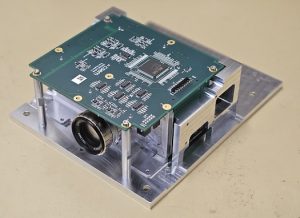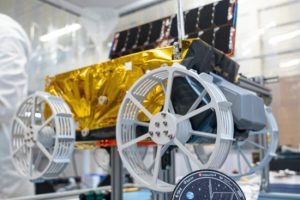The project, which will be used to help deal with space debris – the millions of pieces of junk now orbiting in space. ClearSpace is a Swiss in-orbit services company. The aim is to develop a fully autonomous navigation system based on a flash lidar.
Learning models for point cloud-based 6D pose estimation, deployment capabilities via Klepsydra AI software, and a Guidance, Navigation and Control subsystem for target motion synchronisation, will be included in the system, says the consortium.
While ClearSpace’s immediate goal is to remove failed satellites it anticipates extending its capabilities to increasing the lifetime of such satellites by refueling or repairing them.
It highlights that traditionally used imaging techniques, via cameras and scanning lidars, will not be enough:
“The key operational technology required for rendezvous and docking is called relative navigation. Cameras are sufficient for specific IOS tasks, such as the removal of a specific satellite currently under development in the ESA-funded ADRIOS project (pictured). However, because navigation needs to be robust to lighting conditions, e.g., be successful even when the target cannot be seen with the naked eye, flash lidars emerge as a variable solution. They produce full 3D images with a single laser pulse, thus overcoming the drawbacks of cameras which require good visibility, and of scanning lidars, whose acquisition time is too long to handle moving objects.”
Innosuisse
The project is supported by the Swiss innovation agency Innosuisse. As well as ClearSpace itself, also involved is Zurich-based Klepsydra Technologies, which provides high-performance data processing, and CSEM, a Swiss R&D centre specialising in precision manufacturing, digitalization and renewable energy. The Swiss Federal Institute of Technology is based in Lausanne.
Citing the ESA, which states that over 35,000 objects over 10 centimeters are circling around Earth, the organisations highlight that if you count tiny debris between 1mm and 1cm in size, the number rises to 130 million objects. Revolving around the Earth at a speed of 28,000 km/h, these debris turn into projectiles that threaten any activity in space.
“We are proud to foster space sustainability by supporting ClearSpace. To our belief, answering the rapid developments of ‘New Space assets’ need to be matched by ‘New Space solutions’,” said Antoine Ummel, project manager at CSEM.
“This challenging goal pushed us to make our lidars smaller, stronger, and smarter for space. The developed technology is suitable for other applications such as underwater 3D imaging.”
Incidentally, believes the developed technology will be suitable for other applications, such as underwater 3D imaging.
Image: CSEM – an ADRIOS LiDAR prototype model
See also: ClearSpace space debris removal raises €27m Series A
 Electronics Weekly Electronics Design & Components Tech News
Electronics Weekly Electronics Design & Components Tech News




